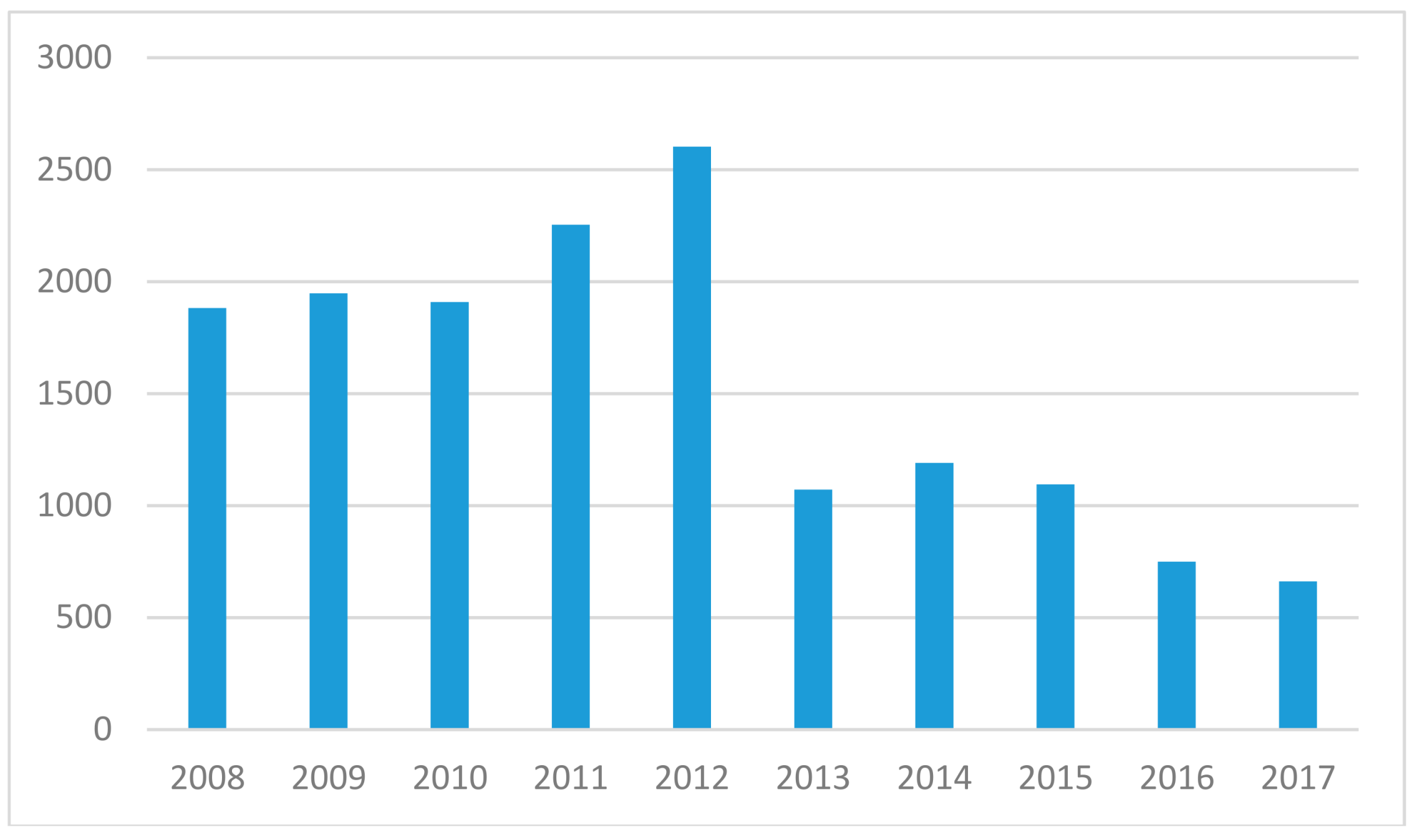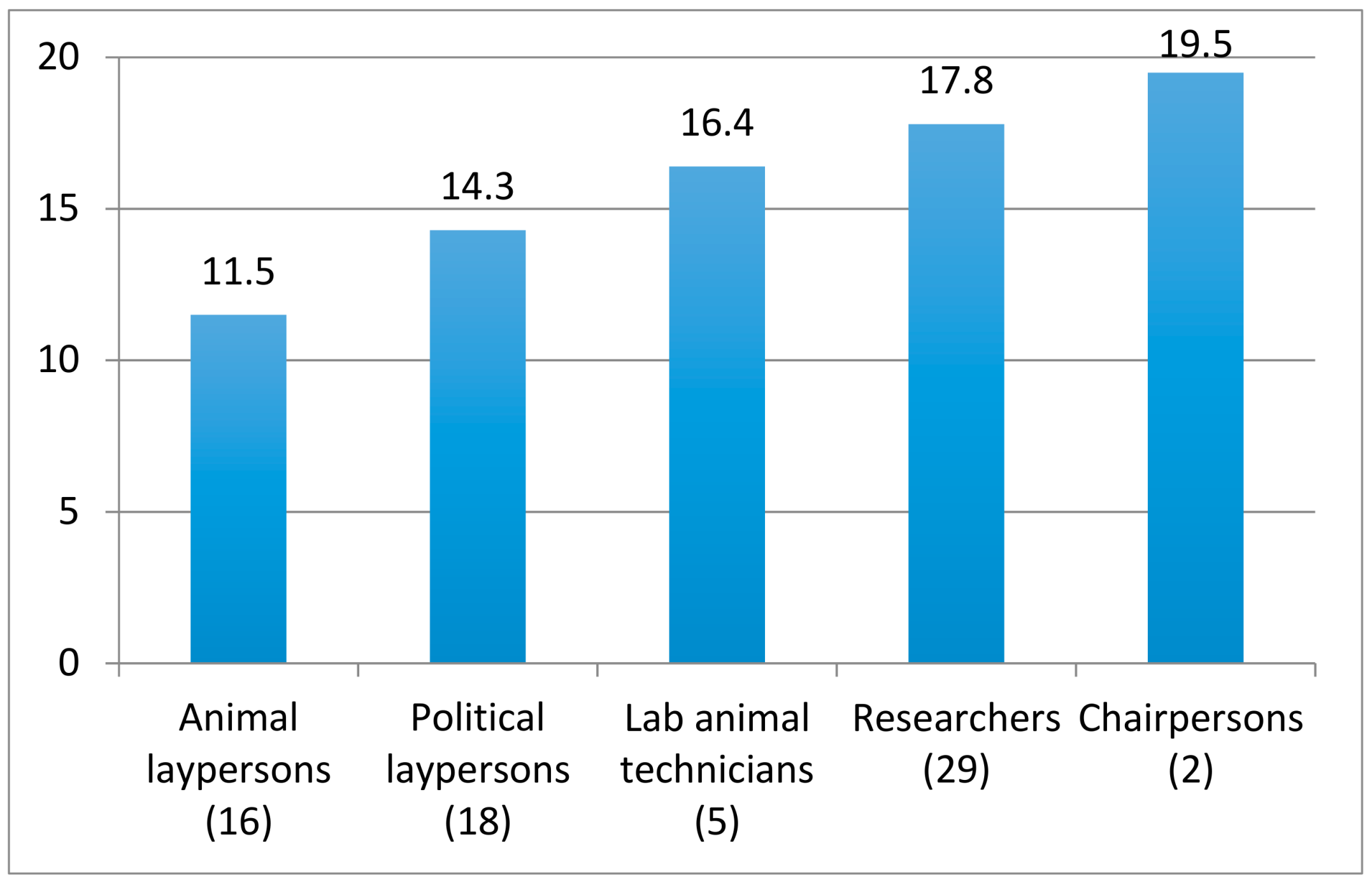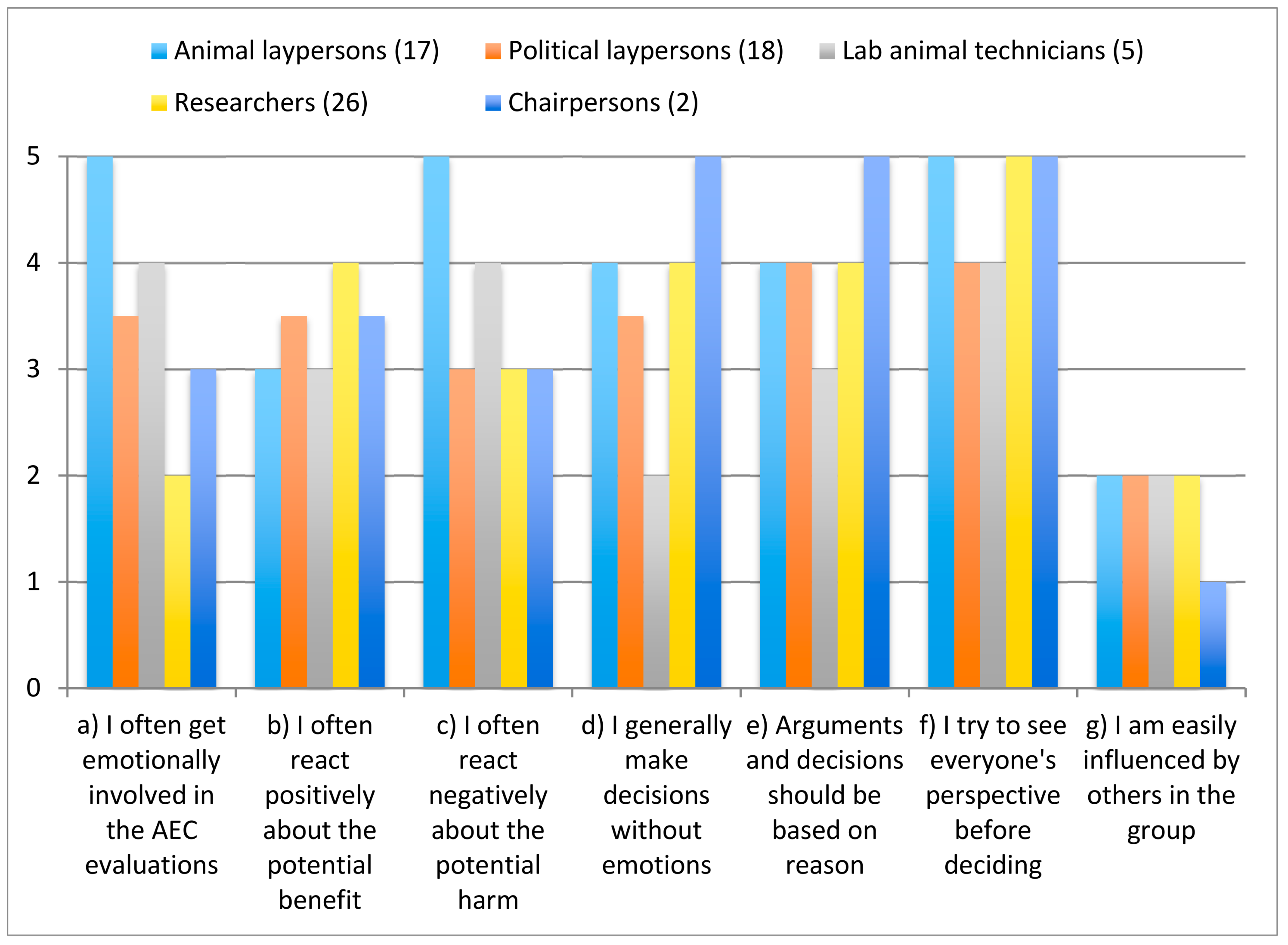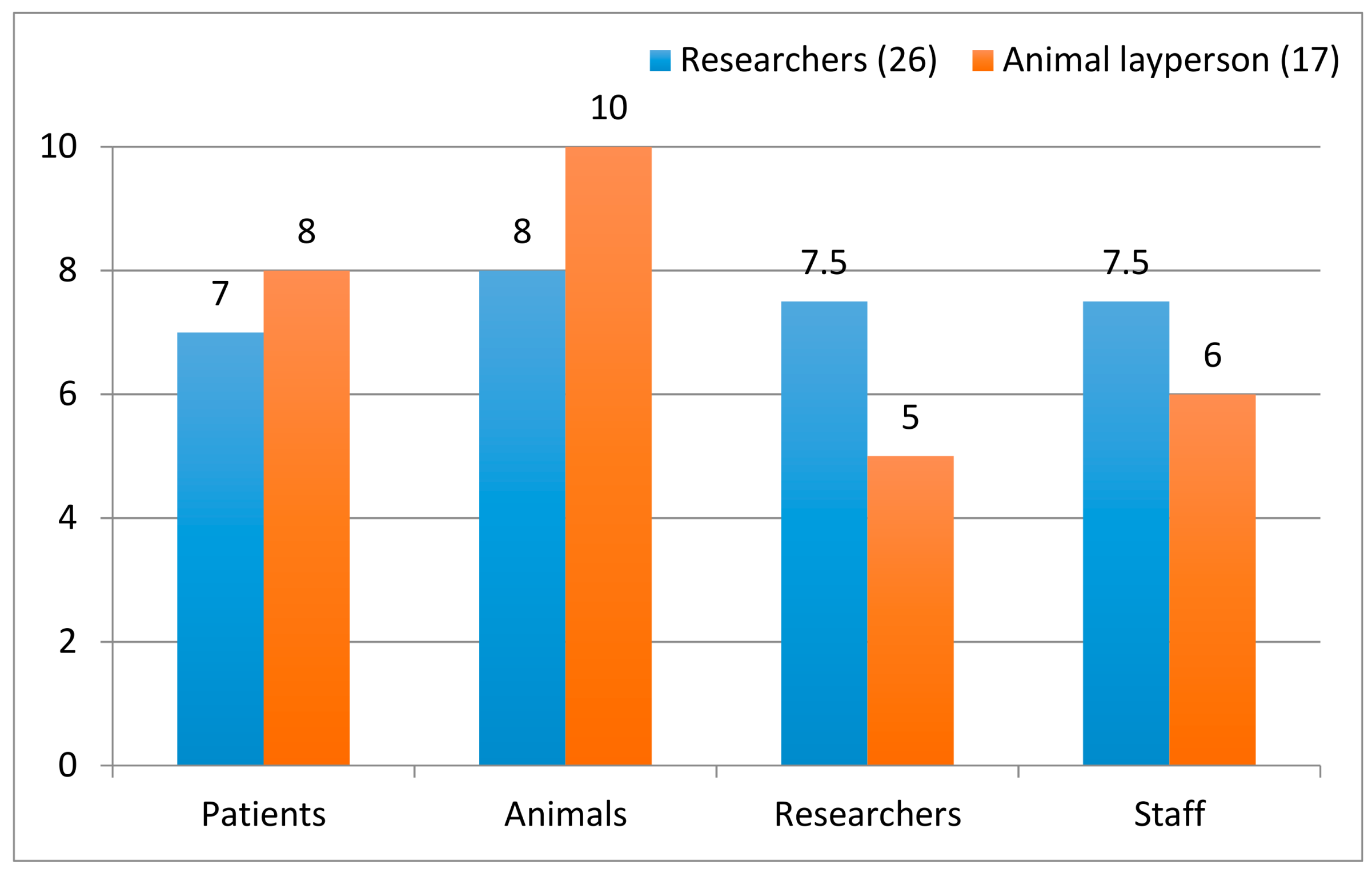Emotions and Ethical Decision-Making in Animal Ethics Committees
Simple Summary
Abstract
1. Introduction
1.1. The Moral Practice of AECs
1.2. The Moral Emotion as the Origin of Morality
1.3. Scientific Norms and Emotions
1.4. Aims of the Study
2. Materials and Methods
2.1. Quantitative Survey
2.2. Qualitative Interviews
3. Results
3.1. Survey
3.1.1. Experience of Work in the Committees
3.1.2. The Ethical Decision-Making Process
3.1.3. Emotions in the Ethical Decision-Making Process
3.2. Interviews
3.2.1. Experience of Work in the Committees
3.2.2. The Ethical Decision-Making Process
3.2.3. Emotions in the Ethical Decision-Making Process
4. Discussion
5. Conclusions
Supplementary Materials
Author Contributions
Funding
Acknowledgments
Conflicts of Interest
Appendix A. Survey
Appendix B. Interview Questions
References
- Alexius Borgström, K. Djuren, Läkarna och Lagen: En rättslig Studie om Djurförsöksetik; Iustus Förlag: Uppsala, Sweden, 2009. [Google Scholar]
- Preece, R. Awe for the Tiger, Love for the Lamb: A Chronicle of Sensibility to Animals; UBC Press: Vancouver, BC, Canada, 2002. [Google Scholar]
- European Commission. Animal Welfare News; European Commission: Luxembourg, June 2015. [Google Scholar]
- Russow, L.-M. Bioethics, Animal Research, and Ethical Theory. ILAR J. 1999, 40, 15–21. [Google Scholar] [CrossRef] [PubMed]
- Matthiessen, L.; Lucaroni, B.; Sachez, E. Towards responsible animal research. EMBO Rep. 2003, 4, 104–107. [Google Scholar] [CrossRef] [PubMed]
- Directive 2010/63/EU of the European Parliament and of the Council of 22 September 2010 on the Protection of Animals Used for Scientific Purposes; European Commission, Ed.; European Union: Brussels, Belgium, 2010. [Google Scholar]
- Röcklinsberg, H. Lay Persons Involvement and Public Interest. Ethical Assessment in Animal Ethics Committees in Sweden. The Swedish Transition Process of the EU Directive 2010/63/EU With Regard to Harm-Benefit Analysis in Animal Ethics Committees. ALTEX 2015, 4, 45–48. [Google Scholar]
- SOU 2007:57. Etiskt Godkännande av djurförsök—Nya Former för Överprövning. Betänkande av 2006 års Djurförsöksetiska Utredning; Statens Offentliga Utredningar: Stockholm, Sweden, 2007.
- Hagelin, J.; Hau, J.; Carlsson, H.E. The refining influence of ethics committees on animal experimentation in Sweden. Lab. Anim. 2003, 37, 10–18. [Google Scholar] [CrossRef] [PubMed]
- Jordbruksverket. Beslut om de Regionala Djurförsöksetiska Nämndernas Antal, Placering, Ärendefördelning Samt Antal Ledamöter, Dnr 5.2.18-4703/15. 2015. Available online: http://www.jordbruksverket.se/download/18.50714f9714e488b2613348c0/1435752367546/Beslut+om+ny+antal+djurf%C3%B6rs%C3%B6ksetiska+n%C3%A4mnder.pdf (accessed on 7 August 2018).
- Forsman, B. Djurförsök. Forskningsetik, Politik, Epistemology; Almqvist & Wiksell International: Göteborg, Sweden, 1992. [Google Scholar]
- SOU 1989:75. Etisk Granskning av Medicinsk Forskning. De Forskningetiska Kommitteernas Versamhet: En Underlagsstudie Från den Forskningsetiska Utredningen; Statens Offentliga Utredningar: Stockholm, Sweden, 1989.
- SFS 1988:539. Djurskyddsförordningen [The Swedish Animal Welfare Ordinance]. Available online: http://extwprlegs1.fao.org/docs/pdf/swe19545E.pdf (accessed on 7 August 2018).
- Jordbruksverket. Årsredovisning (The Swedish Board of Agriculture, Annual Report); Swedish Board of Agriculture: Jönköping, Sweden, 2017; p. 192. (In Swedish) [Google Scholar]
- Jordbruksverket. Årsredovisning (The Swedish Board of Agriculture, Annual Report); Swedish Board of Agriculture: Jönköping, Sweden, 2014; p. 184. (In Swedish) [Google Scholar]
- Jordbruksverket. Årsredovisning (The Swedish Board of Agriculture, Annual Report); Swedish Board of Agriculture: Jönköping, Sweden, 2011; p. 180. (In Swedish) [Google Scholar]
- Jordbruksverket. Årsredovisning (The Swedish Board of Agriculture, Annual Report); Swedish Board of Agriculture: Jönköping, Sweden, 2008; p. 150. (In Swedish) [Google Scholar]
- SFS 2012:675. Förordning om Ändring i Djurskyddsförordningen (1988:539). 2012. Available online: https://www.lagboken.se/Lagboken/sfs/sfs/2012/600-699/d_1451408-sfs-2012_675-forordning-om-andring-i-djurskyddsforordningen-1988_539 (accessed on 7 August 2018).
- Sengupta, S.; Lo, B. The roles and experiences of nonaffiliated and non-scientist members of institutional review boards. Acad. Med. J. Assoc. Am. Med. Coll. 2003, 78, 212–218. [Google Scholar] [CrossRef]
- Ideland, M. Different views on ethics: How animal ethics is situated in a committee culture. J. Med. Ethics 2009, 35, 258–261. [Google Scholar] [CrossRef] [PubMed]
- Röcklinsberg, H.; Gjerris, M.; Olsson, I.A.S. Animal Ethics in Animal Research; Cambridge University Press: Cambridge, UK, 2017. [Google Scholar] [CrossRef]
- Rollin, B.E. The regulation of animal research and the emergence of animal ethics: A conceptual history. Theor. Med. Bioeth. 2006, 27, 285–304. [Google Scholar] [CrossRef] [PubMed]
- Herzog, H.A. The moral status of mice. Am. Psychol. 1988, 43, 473–474. [Google Scholar] [CrossRef]
- Varga, O. Critical Analysis of Assessment Studies of the Animal Ethics Review Process. Animals 2013, 3, 907–922. [Google Scholar] [CrossRef] [PubMed]
- Plous, S.; Herzog, H. Reliability of protocol reviews for animal research. Science 2001, 293, 608–609. [Google Scholar] [CrossRef] [PubMed]
- Schuppli, C.A. Decisions about the Use of Animals in Research: Ethical Reflection by Animal Ethics Committee Members. Anthrozoos Multidiscip. J. Interact. People Anim. 2011, 24, 409–425. [Google Scholar] [CrossRef]
- Hills, A.M. The motivational bases of attitudes toward animals. Soc. Anim. 1993, 1, 111–128. [Google Scholar] [CrossRef]
- Klein, G.A. Sources of Power: How People Make Decisions; MIT Press: Cambridge, MA, USA, 1998. [Google Scholar]
- Lehto, K.; Hirsjärvi, P. Basic assumption was that this is scientific research and important in itself—A discourse analytic study on local ethical committees in Finland. In Proceedings of the New Paradigms in Lab Animal Science Joint Proceedings of the Eleventh Symposium and the 40th Scand-LAS symposium, Helsinki, Finland, 14–17 June 2010; pp. 53–57. [Google Scholar]
- Holmberg, T. A Feeling for the Animal: On Becoming an Experimentalist. Soc. Anim. 2008, 16, 316–335. [Google Scholar] [CrossRef]
- Holmberg, T.; Ideland, M. Secrets and lies: “Selective openness” in the apparatus of animal experimentation. Public Underst. Sci. 2012, 21, 354–368. [Google Scholar] [CrossRef] [PubMed]
- Hansen, L.A.; Goodman, J.R.; Chandna, A. Analysis of animal research ethics committee membership at american institutions. Animals 2012, 2, 68–75. [Google Scholar] [CrossRef] [PubMed]
- Ellis, B. Humanism and morality. Sophia 2011, 50, 135–139. [Google Scholar] [CrossRef]
- Maibom, H.L. Feeling for Others: Empathy, Sympathy, and Morality1. Inquiry 2009, 52, 483–499. [Google Scholar] [CrossRef]
- Stone, V. The moral dimensions of human social intelligence. Philos. Explor. 2006, 9, 55–68. [Google Scholar] [CrossRef]
- Hoffman, M.L. Empathy and Moral Development: Implications for Caring and Justice; Cambridge University Press: Cambridge, UK, 2001. [Google Scholar]
- Goleman, D. Känslans Intelligens: Om att Utveckla vår Emotionella Kapacitet för ett Tryggare och Mänskligare Samhälle (H. du Rietz Övers); (Originalarbete Publicerat 1995); Wahlström & Widstrand: Stockholm, Sweden, 1998. [Google Scholar]
- Biller-Andorno, N. Can They Reason? Can They Talk? Can We Do without Moral Price Tags in Animal Ethics? Appl. Ethics Anim. Res. 2002, 25, 25–54. [Google Scholar]
- Haidt, J. The emotional dog and its rational tail: A social intuitionist approach to moral judgment. Psychol. Rev. 2001, 108, 814. [Google Scholar] [CrossRef] [PubMed]
- Mencl, J.; May, D.R. The Effects of Proximity and Empathy on Ethical Decision-Making: An Exploratory Investigation. J. Bus. Ethics 2008, 85, 201–226. [Google Scholar] [CrossRef]
- Nussbaum, M.C. Upheavals of Thought: The Intelligence of Emotions; Cambridge University Press: Cambridge, UK, 2003. [Google Scholar]
- Guerrini, A. Experimenting with Humans and Animals: From Galen to Animal Rights; JHU Press: Baltimore, MD, USA, 2003. [Google Scholar]
- Galvin, S.L.; Herzog, H.A. The ethical judgment of animal research. Ethics Behav. 1992, 2, 263–286. [Google Scholar] [CrossRef] [PubMed]
- Göthlin, K.; Lantz, G. Rum för Etik: Om Etiska Grupper i Sjukvården; Gothia i Samarbete med Ersta Vårdetiska Institut: Stockholm, Sweden, 1993. [Google Scholar]
- Ringblom, J.; Tornqvist, E.; Hansson, S.O.; Ruden, C.; Oberg, M. Assigning ethical weights to clinical signs observed during toxicity testing. Altex 2017, 34, 148–156. [Google Scholar] [CrossRef] [PubMed]
- Likert, R. A Technique for the Measurement of Attitudes. Arch. Psychol. 1932, 140, 55. [Google Scholar]
- McKnight, P.E.; Najab, J. Mann-Whitney U Test. In The Corsini Encyclopedia of Psychology; Wiley: Hoboken, NJ, USA, 2010. [Google Scholar] [CrossRef]
- Braun, V.; Clarke, V. Using thematic analysis in psychology. Qual. Res. Psychol. 2006, 3, 77–101. [Google Scholar] [CrossRef]
- Nussbaum, M.C.; Zivkovic, Z. Känslans Skärpa, Tankens Inlevelse: Essäer om Etik och Politik; B. Östlings Bokförl. Symposion: Stockholm, Sweden, 1995. [Google Scholar]
- Hoff, D. Varför Etiska Kommittéer? Lund University: Lund, Sweden, 2004; Volume 20. [Google Scholar]
- Röcklinsberg, H.; Gamborg, C.; Gjerris, M. A case for integrity: Gains from including more than animal welfare in animal ethics committee deliberations. Lab. Anim. 2014, 48, 61–71. [Google Scholar] [CrossRef] [PubMed]
- Jones, T.M. Ethical decision making by individuals in organizations: An issue-contingent model. Acad. Manag. Rev. 1991, 16, 366–395. [Google Scholar] [CrossRef]
- Mattison, M. Ethical decision making: The person in the process. Soc. Work 2000, 45, 201–212. [Google Scholar] [CrossRef] [PubMed]
- Young, I. Responsibility for Justice; Oxford University Press: New York, NY, USA, 2011. [Google Scholar]
- Midgley, M. Animals and Why They Matter; University of Georgia Press: Athens, GA, USA, 1998. [Google Scholar]
- Schuppli, C.A.; Fraser, D. Factors influencing the effectiveness of research ethics committees. J. Med. Ethics 2007, 33, 294–301. [Google Scholar] [CrossRef] [PubMed]
- Abrams, D.; Wetherell, M.; Cochrane, S.; Hogg, M.A.; Turner, J.C. Knowing what to think by knowing who you are: Self-categorization and the nature of norm formation, conformity and group polarization. Br. J. Soc. Psychol. 1990, 29, 97–119. [Google Scholar] [CrossRef] [PubMed]
- Hirschleifer, D. The blind leading the blind: Social influence, fads, and informational cascades. In The New Economics of Human Behavior; Tommasi, M., Ierulli, K., Eds.; Cambridge University Press: Cambridge, UK, 1995; pp. 188–216. [Google Scholar]
- Berns, G.S.; Chappelow, J.; Zink, C.F.; Pagnoni, G.; Martin-Skurski, M.E.; Richards, J. Neurobiological correlates of social conformity and independence during mental rotation. Biol. Psychiatry 2005, 58, 245–253. [Google Scholar] [CrossRef] [PubMed]
- Habermas, J. Moral Consciousness and Communicative Action; MIT Press: Cambridge, MA, USA, 1990. [Google Scholar]
- Röcklinsberg, H. Consent and consensus in policies related to food–five core values. J. Agric. Environ. Ethics 2006, 19, 285–299. [Google Scholar] [CrossRef]
- De Cook Buning, T. Structural Aspects of the Ethical Assessment: Assumptions and Implications on Animal Protection and Societal Distrust. ALTEX 2015, 4, 12–15. [Google Scholar]
- Donovan, J.; Adams, C. The Feminist Care Tradition in Animal Ethics: A Reader; Columbia University Press: New York, NY, USA, 2007. [Google Scholar]
- De Waal, F. The Age of Empathy: Nature’s Lessons for a Kinder Society; Random House LLC: New York, NY, USA, 2010. [Google Scholar]




| Condensed Meaning Unit | Interpretation of Meaning (Codes) | Theme |
|---|---|---|
| The more unemotional you are the more you are listened to | Experience that expressing emotions is unsuitable | Low status of emotions |
| She was emotional which made it easier to dismiss her | ||
| Those who are empathic get depressed since there is no use | ||
| It is difficult to involve emotions since everything is very abstract | Rational reasoning is favored | |
| Arguments based on facts generally gain more support | ||
| Arguments were generally quite harsh | ||
| One should be professional enough to not let one’s emotions matter | Emotions are seen as irrelevant | |
| It is not that we sit and feel sorry for the animals |
© 2018 by the authors. Licensee MDPI, Basel, Switzerland. This article is an open access article distributed under the terms and conditions of the Creative Commons Attribution (CC BY) license (http://creativecommons.org/licenses/by/4.0/).
Share and Cite
Tjärnström, E.; Weber, E.M.; Hultgren, J.; Röcklinsberg, H. Emotions and Ethical Decision-Making in Animal Ethics Committees. Animals 2018, 8, 181. https://doi.org/10.3390/ani8100181
Tjärnström E, Weber EM, Hultgren J, Röcklinsberg H. Emotions and Ethical Decision-Making in Animal Ethics Committees. Animals. 2018; 8(10):181. https://doi.org/10.3390/ani8100181
Chicago/Turabian StyleTjärnström, Elisabeth, Elin M. Weber, Jan Hultgren, and Helena Röcklinsberg. 2018. "Emotions and Ethical Decision-Making in Animal Ethics Committees" Animals 8, no. 10: 181. https://doi.org/10.3390/ani8100181
APA StyleTjärnström, E., Weber, E. M., Hultgren, J., & Röcklinsberg, H. (2018). Emotions and Ethical Decision-Making in Animal Ethics Committees. Animals, 8(10), 181. https://doi.org/10.3390/ani8100181





